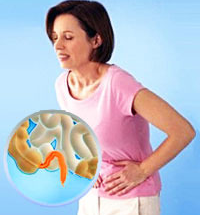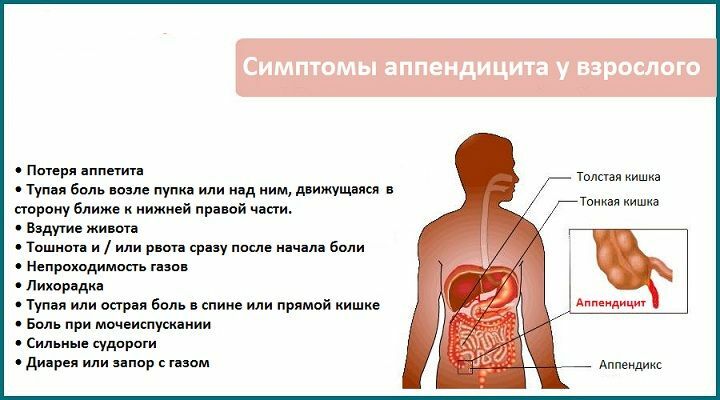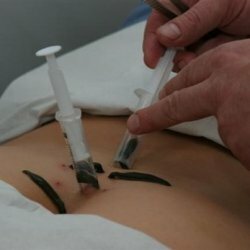How to determine appendicitis at home
 Abdominal pain may indicate an elementary digestive disorder, an infection or an attack of appendicitis.How to determine appendicitis at home?Appendicitis can be acute and chronic - each of these species has its own distinctive symptoms and syndromes, and the treatment will be different.But in almost 97% of cases, appendicitis is treated only surgically. Table of contents: Symptoms of acute appendicitis Chronic appendicitis Recommended to read:
Abdominal pain may indicate an elementary digestive disorder, an infection or an attack of appendicitis.How to determine appendicitis at home?Appendicitis can be acute and chronic - each of these species has its own distinctive symptoms and syndromes, and the treatment will be different.But in almost 97% of cases, appendicitis is treated only surgically. Table of contents: Symptoms of acute appendicitis Chronic appendicitis Recommended to read:
Symptoms of acute appendicitis
The main symptom of acute appendicitis in adults and in children from 7 years old is dull and persistent pain.It is noteworthy that the pain syndrome can begin anywhere in the abdomen, but over time it shifts to the right iliac region - this is just the projection of the anatomical location of the cecum( appendicitis refers to the inflammatory process in this section of the intestine). Note: is a person whose heart is located on the right, which means that pain with acute appendicitis will have localization in the left ileal region( all organs are arranged in a mirror image).
Note: is a person whose heart is located on the right, which means that pain with acute appendicitis will have localization in the left ileal region( all organs are arranged in a mirror image).
- in the daytime, the baby can scream in pain and squat;
- at night the pain intensifies, the child's sleep is disturbed;
- baby becomes restless, points to the abdomen, indicating thus pain.
Nausea and vomiting can be pronounced symptoms in acute appendicitis - the latter in adults and children older than 7 years can appear only 1-2 times, but in young children, vomiting with acute appendicitis is repeated often.Appetite during an attack of acute appendicitis is reduced, or completely absent - this is natural, because a person experiences severe pain.In elderly people, all of the above symptoms of acute appendicitis will be blurred - for example, pain is of a non-intensive nature, vomiting is absent, and nausea only appears periodically.This makes the diagnosis difficult.Please note: doctors in the diagnosis of acute appendicitis conduct palpation of the right iliac region - reveals the tension of the abdominal wall.But at home, diagnosing appendicitis in this way is not recommended - you can cause harm to the patient. There are a number of variative symptoms of acute appendicitis - in some patients they may be completely absent or have a short-term character.These include:
- Stool disorder.If the appendix is located within the limits of the norm, the stool will be unchanged.And in the case of an atypical appendix in adults and with the development of acute appendicitis, children under 7 years of age may experience diarrhea or constipation.It is often a loose stool against the background of abdominal pain and fever that can lead to hospitalization of the patient in the infectious department - this will be a medical error that can lead to serious consequences.
- Hyperemia.In general, an increase in body temperature is not typical for the progression of acute appendicitis.But in young children and with the rapid development of an attack in an adult, body temperature can rise to subfebrile indicators( 37-37, 5 degrees).
- Atypical symptoms.These are signs of acute appendicitis, which are extremely rare.For example, if, by virtue of anatomical features, the appendix is located closer to the urinary system or genital organs, the pain syndrome may spread to the lower back and be of a circumambient nature.In childhood, classic symptoms of a cold or acute respiratory viral infection may appear, and in the elderly, chronic appendicitis can exacerbate chronic pathologies.
Chronic appendicitis
This form of the pathology under consideration is extremely rare and inherent in adults.Symptoms of chronic appendicitis may be identical to those of an acute form of the inflammatory process, but represent a blurred clinical picture. The most characteristic symptom of chronic appendicitis is the periodically appearing intense dull pain in the right ileal region.The danger of developing the chronic form of the inflammatory process under consideration lies in the high probability of rupture of the appendix and the development of peritonitis.Abdominal pain, nausea and vomiting, increased body temperature can help with the diagnosis of appendicitis at home.But!It is necessary for the appearance of the first signs of acute or chronic inflammatory process in the appendix of the cecum to call the doctor - only the specialist after the examination of the patient can determine the exact diagnosis and conduct competent treatment. Yana Tsygankova, medical reviewer, therapeutist of the highest qualification category.
The most characteristic symptom of chronic appendicitis is the periodically appearing intense dull pain in the right ileal region.The danger of developing the chronic form of the inflammatory process under consideration lies in the high probability of rupture of the appendix and the development of peritonitis.Abdominal pain, nausea and vomiting, increased body temperature can help with the diagnosis of appendicitis at home.But!It is necessary for the appearance of the first signs of acute or chronic inflammatory process in the appendix of the cecum to call the doctor - only the specialist after the examination of the patient can determine the exact diagnosis and conduct competent treatment. Yana Tsygankova, medical reviewer, therapeutist of the highest qualification category.



